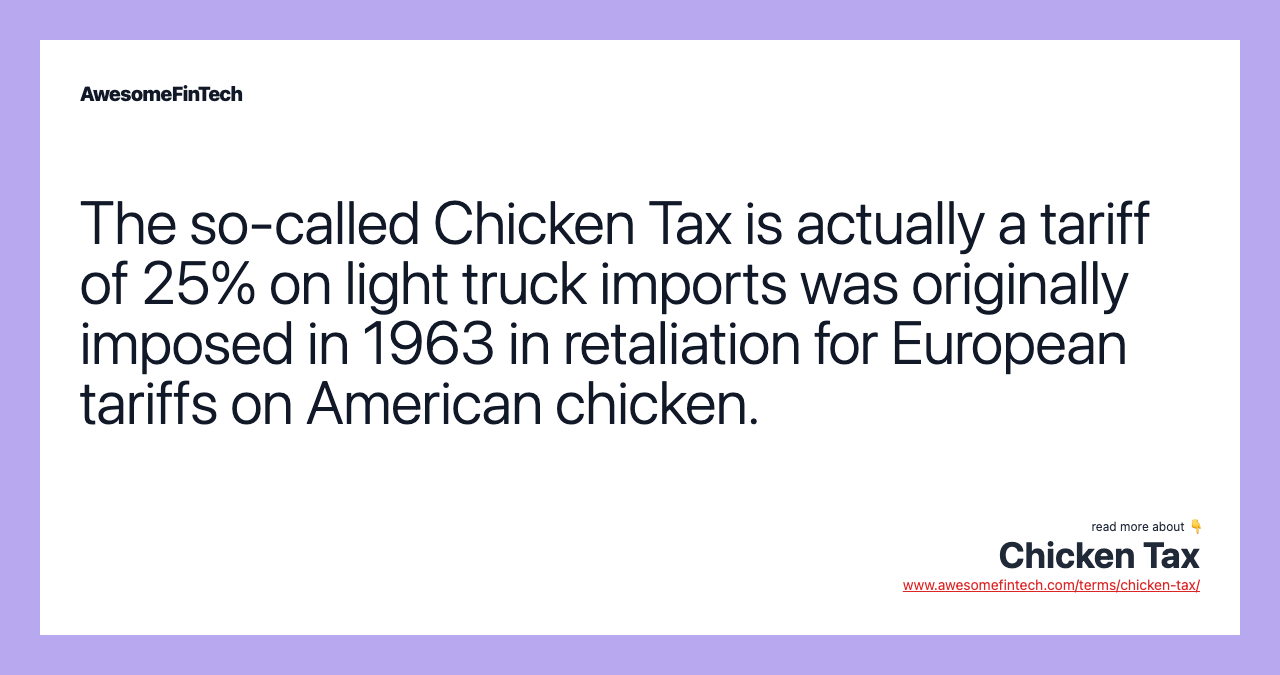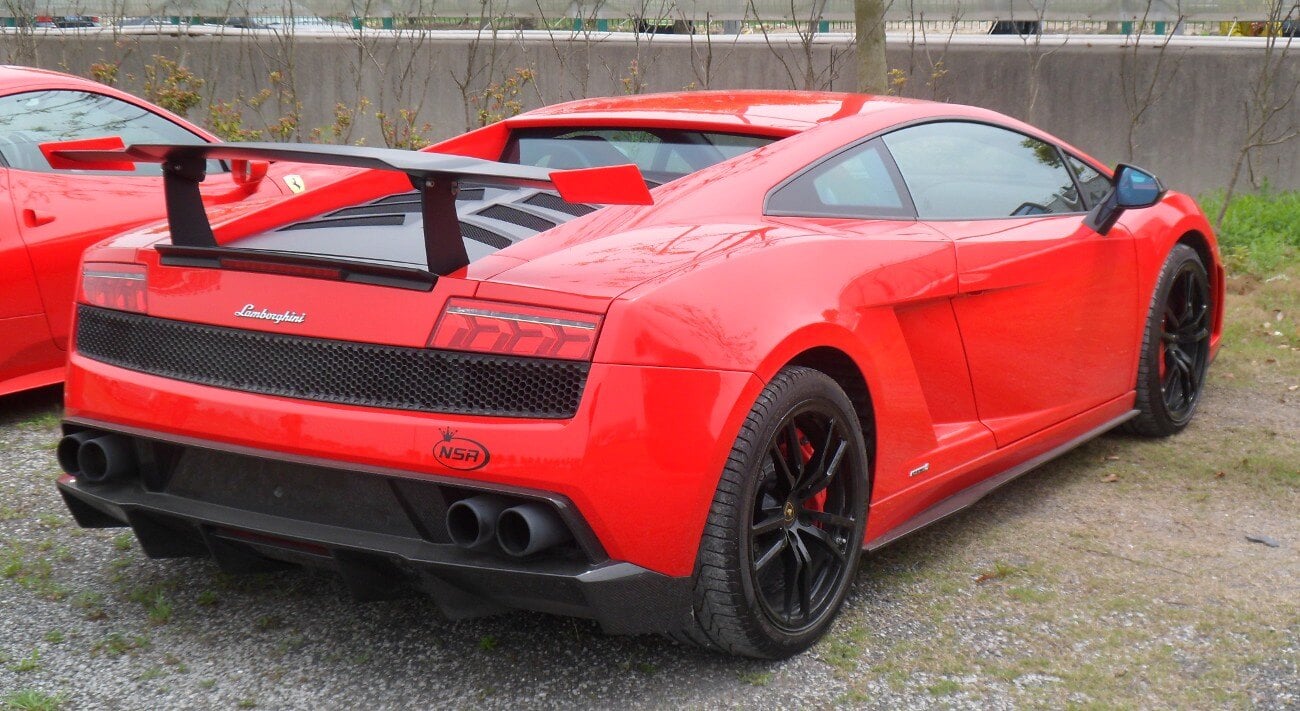Have you ever wondered why pickup trucks dominate American roads while smaller more efficient trucks are nowhere to be seen? Or why Ford F-150s have been America’s bestselling vehicle for decades? The answer might surprise you – it’s all because of chickens!
Yes, you read that right Chickens
I’m about to take you on a fascinating journey through one of the strangest trade policies still affecting our daily lives: The Chicken Tax. This 25% tariff on light trucks imported to the U.S. has shaped our automotive landscape for over 60 years, and chances are, you’ve never even heard of it.
What Exactly Is The Chicken Tax?
The Chicken Tax is a 25% tariff (that’s a fancy word for import tax) placed on light trucks that are imported into the United States It’s been around since 1964, making it one of the longest-standing trade policies still in effect today
But wait – why on earth is it called the “Chicken Tax”? Well, the story is kinda wild.
The Poultry Problem: How It All Started
Back in the early 1960s, American farmers got really good at raising chickens. Like, REALLY good. Thanks to industrial farming methods developed after World War II, U.S. chicken production exploded, and prices dropped dramatically.
Suddenly, chicken wasn’t just for Sunday dinners anymore – it became an affordable everyday meal for Americans. And we had TONS of extra chicken to export to Europe.
European farmers, still struggling to recover from World War II, weren’t too happy about this flood of cheap American chicken. A 1962 Time magazine article noted that chicken consumption in West Germany rose 23% in 1961 alone, mostly from American imports.
European farmers complained that American farmers were taking over the market and pushing them out of business. By late 1961, France and Germany had imposed tariffs and price controls on U.S. chickens.
American poultry producers were losing their minds (and money). By the end of 1962, they estimated they’d lost about 25% of their sales due to European intervention.
The Perfect Storm: Chickens Meet Cars
At the same time as this chicken drama was unfolding, the American auto industry was having its own crisis. Imports of Volkswagen cars (especially the Beetle and Type 2 van) were surging in the early ’60s.
President Lyndon B. Johnson was caught in the middle of all this. He was trying to:
- Resolve the chicken dispute with Europe
- Help the struggling American auto industry
- Keep the United Auto Workers (UAW) from striking before the 1964 election
- Get union support for his civil rights agenda
Talk about juggling multiple problems!
The Retaliatory Strike: Proclamation 3564
On December 4, 1963, President Johnson issued an executive order called Proclamation 3564. This order imposed tariffs on several European goods, including:
- Potato starch
- Dextrin
- Brandy
- And most importantly, light trucks
The tariff went into effect on January 7, 1964. This was America’s way of saying, “You tax our chickens, we’ll tax your trucks!”
The Aftermath: A Tax That Outlived Its Purpose
Here’s where things get interesting. Over time, all the other tariffs from that executive order were eventually lifted or reduced. But the 25% tariff on light trucks? It’s STILL HERE, over 60 years later!
Volkswagen sales of trucks and vans in the U.S. plummeted almost immediately. American automakers quickly realized this tariff gave them a huge advantage in the truck market, and they’ve lobbied hard to keep it in place ever since.
Why Does The Chicken Tax Still Matter Today?
You might be thinking, “OK, interesting history lesson, but why should I care about some old tax from the ’60s?”
Well, the Chicken Tax has had profound effects on our automotive landscape that we still see today:
1. American Truck Dominance
The most obvious impact is that American-made trucks still dominate truck sales in the U.S. The Ford F-150 has been America’s best-selling vehicle for decades, making Ford approximately $10,000 in profit PER TRUCK.
2. Limited Foreign Competition
The 25% tariff (which is TEN TIMES higher than the import tax on regular cars) effectively eliminated most foreign competition in the light truck market. This limited consumer choices and kept prices higher.
3. Death of the Mini-Truck
Remember those cool little compact trucks from the ’80s and ’90s? In 1985, mini-trucks made up about 25% of pickup trucks sold in the U.S. By 2010, they were completely gone from the market. The Chicken Tax made it too expensive for foreign manufacturers to compete in this segment.
4. Manufacturing Shifts
The tax created some weird workarounds. For example, foreign manufacturers started building assembly plants in the U.S. to avoid the tariff. Others engaged in “tariff engineering” – modifying vehicles or importing them in parts to get around the tax.
5. Environmental Impact
With less pressure from more efficient foreign trucks, American manufacturers focused on building bigger, more profitable trucks rather than improving fuel efficiency. This has contributed significantly to higher emissions.
The Chicken Tax in Today’s World
Despite being a relic from a bygone era, the Chicken Tax continues to influence modern trade policy and the automotive industry.
The tariff has created this weird situation where the U.S. automotive market looks very different from the rest of the world. Other countries have a much wider variety of small, efficient trucks available to consumers.
Here in America, we’ve ended up with massive vehicles that are often overkill for most people’s needs. Studies show that 70% of pickup owners go off-road once a year or less, 75% tow something once a year or less, and 35% use the truck bed once a year or less.
Basically, most people buying these huge trucks don’t actually NEED huge trucks!
The Light Truck Loophole: Adding Fuel to the Fire
The Chicken Tax isn’t the only policy that’s shaped our truck-heavy landscape. Another major factor is the “Light Truck Loophole” in our emissions regulations.
When the U.S. government created Corporate Average Fuel Economy (CAFE) standards in the 1970s, they divided vehicles into two categories: “passenger cars” and “light trucks.” Since light trucks were mostly used as work vehicles back then, they were subject to more lenient fuel economy and emissions standards.
But today, 80% of new vehicle sales are categorized as light trucks, even though they’re mostly used as passenger vehicles! This has created a situation where:
- SUVs and pickups are held to lower emissions standards
- Larger vehicles actually face EASIER standards than smaller ones
- Manufacturers are incentivized to make bigger vehicles
The Hummer Deduction: More Subsidies for Big Trucks
As if the Chicken Tax and Light Truck Loophole weren’t enough, there’s also Section 179 of the Internal Revenue Code, nicknamed the “Hummer Deduction.”
This tax provision allows business owners to immediately deduct the value of a light truck weighing over 6,000 lbs that is used for business at least half the time.
So if you’re a realtor showing houses, why buy a Toyota Camry when you can get a massive Cadillac Escalade with a $25,000 tax discount? Even luxury brands like Bentley and Porsche make vehicles that qualify!
This has encouraged manufacturers to add weight to their vehicles just to cross that 6,000 lb threshold for tax benefits.
The Impact on Our Roads, Wallets, and Planet
All these policies have had serious consequences:
Safety Concerns
The average new car in 2022 weighed more than two tons – that’s 1,000 lbs heavier than the average car in 1980! These bigger vehicles are deadly – light trucks are 2-3 times more likely to kill pedestrians than smaller vehicles and 55% more dangerous to cyclists.
Environmental Damage
SUVs were the second-largest contributor to the increase in global carbon emissions from 2010 to 2018, ahead of heavy industry, trucks, and aviation. Between 2020 and 2021, the average new vehicle’s fuel economy stayed at a dismal 25.6 miles per gallon.
Economic Costs
Bigger vehicles cost more to buy, more to fuel, and more to maintain. They also cause more damage to roads and infrastructure. One study estimated that fuel economy improvements between 1980 and 2006 would have been more than tripled if vehicles hadn’t seen such growth in weight and power.
Is It Time to Pluck the Chicken Tax?
Many experts argue that the Chicken Tax has outlived its usefulness. Critics point out that it:
- Limits consumer choice
- Keeps prices artificially high
- Stifles innovation
- Protects an industry that no longer needs protection
Proponents, however, argue that it:
- Protects American jobs
- Ensures a strong domestic auto industry
- Prevents foreign manufacturers from flooding the market
What’s the Future of the Chicken Tax?
So will the Chicken Tax ever go away? It’s tough to say. The automotive industry has powerful lobbying influence, and the tax has become deeply embedded in our economic ecosystem.
Some trade negotiations have discussed phasing it out, but so far, it remains firmly in place. The auto industry continues to profit handsomely from the protection it provides.
What Can We Learn From The Chicken Tax?
The Chicken Tax is a fascinating example of how a temporary retaliatory measure can become a permanent fixture with far-reaching consequences. It shows how policies created for one purpose can end up shaping industries and consumer behavior in ways no one could have predicted.
It’s also a reminder that our choices as consumers are often influenced by invisible policies and regulations that we know nothing about. The next time you see a massive pickup truck rolling down the street, remember – you’re seeing the lasting legacy of a chicken dispute from the 1960s!
Wrapping It Up
So there you have it – the strange and fascinating story of the Chicken Tax. What started as a trade spat over poultry has shaped American roads, influenced global manufacturing, affected environmental outcomes, and impacted safety for generations.
I find it kinda mind-blowing that something so random as a chicken dispute could have such long-lasting effects on what we drive. It just goes to show that in our interconnected global economy, even the smallest policies can have the biggest impacts.
What do you think? Is it time to finally get rid of the Chicken Tax? Or does it still serve an important purpose in today’s world? I’d love to hear your thoughts in the comments below!
Until next time, keep an eye out for those big American trucks on the road – now you know the clucking reason they’re everywhere!

Trump’s 25% Tariff on Imported Cars – Impact on Car Imports & Wholesale Trade

You May Also Like

The Chicken Tax – What It Is & How It Changed Pickup Trucks Forever!
FAQ
What is the chicken tax?
The Chicken Tax is a 25 percent tariff on light trucks (and originally on potato starch, dextrin, and brandy) imposed in 1964 by the United States under President Lyndon B. Johnson in response to tariffs placed by France and West Germany on importation of U.S. chicken.
Does the chicken tax still exist?
While U.S. tariff rates on industrial imports have decreased, the Chicken Tax remains. President Johnson included light trucks in the tax to address issues in the American auto industry. Today, lobbying efforts by the auto industry have kept the tax in place. The Chicken Tax is a 25% tariff imposed on imported light trucks in the United States.
How did the chicken tax get its name?
The Chicken Tax or Chicken Tariff received its name after several European nations imposed tariffs and other restrictions on imported American birds, particularly chicken. American farmers lost significant income, and their market position dwindled.
Was the chicken tax a concession to Reuther?
Historians insist that the so-called Chicken Tax (the automotive part) was a concession to United Auto Workers President Walter Reuther, who communicated to the administration that the Big Three were concerned about the importation of light trucks from overseas. What light truck would that be?
Why is the chicken tax on trucks still in effect today?
Thanks to lobbying by the automotive industry, the Chicken Tax on trucks remains in effect today. This is ironic because the original targets of the executive order (potato starch, brandy, and dextrine) have since been eliminated from the tariffs.
What did the chicken tax accomplish?
What the Chicken Tax arguably did accomplish was having foreign manufacturers build trucks either in the United States or in countries that were at least covered under the North American Free Trade Agreement, which included Canada and Mexico.
How does the Chicken Tax work?
Chicken Tax 101 – A 25 Percent Tariff That Hatched From Poultry. In 1962 the European Economic Community slapped high duties on U.S. frozen-chicken exports. Two years later President Lyndon B. Johnson retaliated, imposing a 25 percent tariff on four categories, including potato starch, dextrin, brandy—and light trucks.
What is the loophole in the Chicken Tax?
To get around the chicken tax, some foreign automakers shipped trucks to the United States without the truck beds attached to the chassis. Others added extra seats so that the trucks were classified as passenger vehicles. The Subaru BRAT added two rear facing seats in its truck bed.
How to avoid the Chicken Tax?
One common strategy employed by foreign manufacturers is the use of “knock-down” kits. These are partially assembled vehicles that are shipped to the US and then completed domestically. This allows them to avoid the Chicken Tax, as the vehicles are technically manufactured in the US.
Why is the Chicken Tax still in place?
U.S. intensive chicken farming led to the 1961–1964 “Chicken War” with Europe. Eventually, the tariffs on potato starch, dextrin, and brandy were lifted, but since 1964 this form of protectionism has remained in place to give US domestic automakers an advantage over imported competitors.
